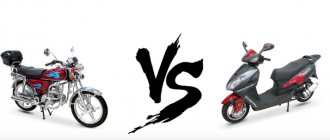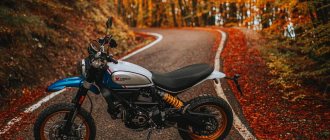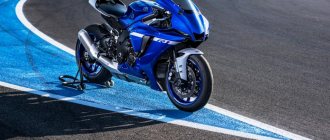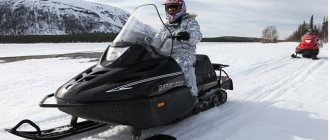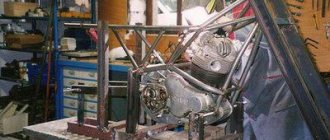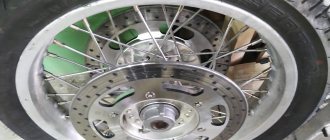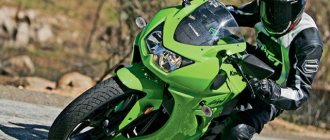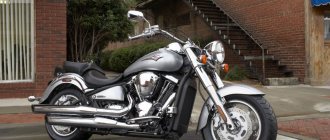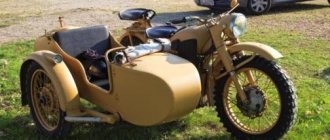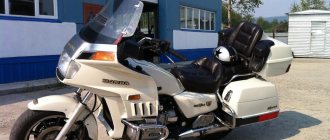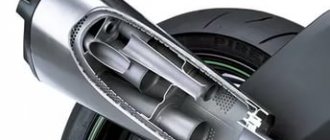The advent of steam engines contributed to the further development of bicycles and led to the emergence of motorcycles. It is believed that the first steam motorcycle was created in 1868. Frenchman Erne Michaud. This vehicle had a small steam engine, a large front wheel and a small rear wheel. The steam engine did not work reliably, and therefore, to be on the safe side, Michaud installed pedals on his brainchild with a drive to the front wheel.
History also knows the steam motorcycle of the French engineer Louis-Guillaume Perrault, created in 1871, and the design of the American Louis Copland. In 1884, Compland placed a steam engine in front of the driver above the small front wheel to relieve the load on the rear. This motorcycle could accelerate to 18 km/h, rushing through the streets like a “fiend from hell” and frightening citizens.
However, at the end of the 19th century. the creation of new types of motorcycles has slowed down. The people involved in their manufacture were faced with the same problem as automobile craftsmen - the lack of a light and economical engine. Only the advent of the internal combustion engine led to the further development of this original type of transport.
Custom
The name of the types of motorcycles, photos of which are presented below, is translated as made to order.
They are further divided into a number of subspecies, the features of which will be discussed below. This designation is inherent in machines that are produced in a strictly limited series or in single copies. Often, such versions are created by folk craftsmen who combine the characteristics of various representatives of two-wheeled vehicles in one bike. This allows you to satisfy all the “whims” of demanding buyers and collectors. There is an assumption that the “custom” category includes motorcycles assembled by the owner or supplier, which have unique parameters and exterior.
Popular mass-producers in this area include Harley Davidson and Honda. But a unit from any manufacturer can be remade in such a way that it is classified as custom. Among other mass manufacturers of similar models:
- Bourget.
- American IronHorse.
The manufacturer offers the buyer several versions of the “iron horse” equipment, including different color options, engine characteristics, and a set of additional options and accessories. In addition, the companies provide a guarantee and service support. Absolute individuality of the bike is unlikely to be achieved, however, the advantages of factory production and safety will be preserved.
Among the disadvantages of custom, the following points are noted:
- high price of popular modifications;
- the need to order spare parts individually.
Classification of motorcycles by type
Main article: Types of motorcycles
Classifications on official dealer websites
For the American and European markets, the range of Japanese motorcycles is presented in a more comprehensive form than for the Japanese. In addition to the general division (on-road, sports and dual-purpose), motorcycles are divided into types depending on the layout and style.
| Honda | Yamaha | Kawasaki | Suzuki | |
| Road | Street: Touring | Touring | Touring | |
| Road | Street: Sport Touring | |||
| Road | Street: Super Sport Touring | Super Sport Touring | ||
| Road | Street: Adventure | Street: Adventure Touring | Adventure | |
| Road | Street: Croisers | Cruisers | Cruiser | |
| Road | Street: Chopper | |||
| Road | Street: Sport | Sport | Sportbike | |
| Road | Street: Super Sport | Super Sport | ||
| Road | Standard | |||
| Road | Street: Motard | |||
| Dual use | OffRoad/Street: Dual Sport | Street: Dual Purpose | Dual Purpose | Dualsport |
| Sports | OffRoad: Motocross | OffRoad: Motocross | Motocross | Motocross |
| Sports | OffRoad: OffRoad | OffRoad | Offroad | |
| Sports | Kids | |||
| Sports | OffRoad:Trail |
Classification proposed by the publishing house "Behind the Wheel"
The classification was first published in 1995, and then, with some additions, it was periodically presented in subsequent editions of the World of Motorcycles catalog with the caveat that, like any classification, it cannot claim completeness, since any motorcycle can move from one category to another through the installation of various accessories, changing tires and other changes. The authors indicate the purpose and layout as the basis for the classification and include not only motorcycles, but also mopeds and scooters. Also, when identifying types, such a parameter as the style of the motorcycle is considered separately.
Minibikes:
- simple designs of moped origin,
- more complex designs of motorcycle origin,
- folding.
Standard or "classic" motorcycles are basic motorcycles that retain the classic simplicity of their styling. A specific group - neoclassics, stylized in the spirit of past years, includes:
- retro motorcycles
, reproducing the style of the 50-70s; - street bikes
, successors to the cafe racers of the 60s; - scramblers
.
Motorcycles made in American style:
- custom
; - choppers
; - cruisers
; - dragsters
; - trainers
;
Sportbikes are usually the most powerful and fastest motorcycles, with the exception of special racing models:
- typical sportbikes
; - sports tourists
; - nakeds
.
Touring motorcycles are the most comfortable for long trips on good roads. This type is sometimes combined with sports tourists and trainers.
Dual-purpose motorcycles - designed for driving both on asphalt roads and off-road, the layout is made in the “enduro” style (it is specially stipulated that the term “enduro” without reservation is used only for cars for purely sports purposes). According to road performance, dual-purpose motorcycles are divided into:
- “hard” - they are closer to sports equipment than other dual-purpose motorcycles, but unlike enduro motorcycles they have a more comfortable seat and passenger footrests;
- “soft” - intended, rather, for roads, but does not exclude movement over rough terrain;
- “tourist” - equipped with large displacement engines, with a more comfortable seating position and are heavier, which makes it difficult to move over rough terrain;
- “urban” - shod with purely road tires, which are therefore unsuitable for off-road use.
Motorcycles for special purposes - equipped with special equipment:
- army;
- police officers;
- firefighters;
- for ambulance, etc.
This also includes off-road motorcycles
.
Sports motorcycles are motorcycles for competitions in various motorcycle disciplines. Are divided into:
- racing (for road racing),
- cross,
- enduro - ,
- trial,
- for rally raids,
- for motorball,
- motards (for supermoto competitions),
- for speedway,
- etc. for other disciplines.
It is also customary to include children's sports motorcycles
- intended for acquiring the first skills of off-road riding.
Motorcycles with sidecars.
All-terrain vehicles (ATV).
Freight motor transport.
Economical and cheap
Mopeds differ from light motorcycles mainly in the presence of a pedal drive and generally repeat the design of the very first motorcycles. Starting the engine is usually done like this: the driver depresses the clutch and starts off pedaling like a bicycle; after gaining speed, he releases the clutch and the engine shaft begins to rotate. After this, you can drive by motor. Since the moped does not have gear shifting, on steep climbs you need to “help” the engine by rotating the pedals.
Nowadays, many companies have abandoned the pedal drive, and instead the motors have received starters. At the same time, the machines themselves safely retained all the other features of a classic moped - a curved frame and an engine suspended from below, the working volume of which, as a rule, does not exceed 50 cm3. With such a motor, this vehicle, whose weight can reach 50 kg, reaches a maximum speed of no more than 50 km/h. The great popularity of mopeds is due to the fact that they are quite cheap and consume little gasoline.
SUVs
This style is suitable for those who like to get away from the bustle of the city. Often these models are called two-wheeled jeeps. Off-road bikes can easily overcome sandy and rocky trails. They are light weight, well controlled, low speed, suitable for beginners in motorcycling. They are distinguished by a high seat and an upward shift of the center of gravity. There are types of enduro and motocross motorcycles.
Cross
These motorcycles cannot be used as a means of transportation; they do not have lights. Their purpose is sports racing, jumping, and off-road travel. A bright representative of cross-country motorcycles is the Honda CRF 450. There is nothing superfluous in the design, only what is necessary for success in the competition. Usually it is a 2-stroke powerful engine, a durable frame, reliable suspension, and starts with a kick starter.
Enduro
The name of this style comes from the Latin “indurare” - endure, withstand. This is a special motorcycle equipment for sports competitions taking place on roads of different surfaces, over rough terrain, with a given schedule of movement over long distances over several days. Motorcycles must cope with different conditions throughout the competition, and therefore differ from road ones.
Enduro Features:
- wide steering wheel, giving good control on uneven roads;
- stability thanks to the large front wheel;
- spoked wheels that can withstand deformation during strong impacts, can be repaired, and are lighter than cast wheels;
- the front mud flap is mounted high so that dirt does not get clogged between it and the wheel;
- tire tread with developed lugs for driving off paved roads;
- chain drive with excellent shock absorption for lighter weight and gear changes;
- a set of lighting equipment and mirrors;
- navigator;
- state registration plates.
At competitions, certain requirements for enduro are specified, for example, minimum weight, engine size, design and length of control levers, and others.
The representative of the enduro style is the Honda Africa Twin.
Motards
A type of enduro, created for busy urban conditions: driving along curbs, stairs and other obstacles. Motards have wheels and brakes like sportbikers, a powerful engine. An excellent style of motorcycle equipment to show off your agile riding. Mottard sample - Suzuki RMZ 450.
For the young and energetic
In the 50-60s. XX century In developed countries, the car became available to a wide segment of the population, and the production of motorcycles was greatly reduced. But not for long - at the end of the century, motorcycles, and especially motor scooters and scooters, began to gain popularity again, but now as a means of overcoming traffic jams in big cities. In addition, the motorcycle came to be used as a symbol of a certain lifestyle, as it was associated with youth, energy and risk. Among amateur motorcyclists, even their own subcultures of bikers and rockers have appeared.
Sports types of motorcycles
Sports motorcycle models are very powerful and beautiful. They are easy to control at any, even critical speed. Sports motorcycles are agile and powerful.
This type of motorcycle is characterized by a powerful engine, the number of horsepower of which can significantly exceed its weight. It is characterized by a sharp engine, six-speed transmission, wide wheels and excellent brakes.
It is very convenient to ride on sports motorcycles, since they have a recumbent seating position, are equipped with enlarged footrests and a fairly low handlebar. Another advantage of this type of motorcycle is its relatively low weight.
However, sports models are not as ideal as it might seem to the average person. Their problematic aspects include:
- the need to correlate the speed of the motorcycle and the wind;
- unusual position, which can cause muscle pain;
- the high cost of the motorcycle itself and its repairs;
- high prices for spare parts and components;
- high fuel consumption;
- fragility of plastic casing.
It should be noted that all sports models should not be used by beginners, since high speed is a constant risk. Driving a vehicle of this kind is the privilege of professionals.
Modernization of the motorcycle in the 20th century.
“Generalized motorcycle” of the first decade of the 20th century. can be represented in the following form: an engine with a power of 1.5-3.5 hp. air-cooled, finally finding its place at the bottom of the middle part of the frame. The frame itself is reinforced with a second horizontal pipe, and a fuel tank is placed in the space between it and the top pipe. The evaporative carburetor was no longer used and was replaced by a spray carburetor, which greatly simplified the adjustment of the mixture. Battery ignition was still installed on some cars, but a number of companies were already using magnetos. Power transmission, as a rule, was carried out by a belt, but some designers used cardan or chain transmission in their models, not without success.
The motorcycle's bicycle pedals remained for quite some time. They were used to start the engine, to help it on inclines and finally when the engine failed. In addition, the pedals replaced the driver's footrests.
Some early motorcycle models had leaf-spring front forks, but this design was controversial and many experts found it to make the ride "unstable and dangerous." But in the 20s. XX century The spring front fork became an integral attribute of the motorcycle, which received a second important improvement during this period - the gearbox.
Type of transport motorcycle road
Depending on the design features, functionality and purpose, road bikes can be divided into “classic”, “sports”, “super-sport”, “sports-touring”, “touring”, “choppers”, “cruisers”, “customized motorcycles” , “dragsters”, “scarvers”, mini-bikes” and heavy motorcycles”.
As you can see, there are many subclasses. And no wonder! This type of transport, such as a motorcycle, has been in widespread use for more than 100 years. During this time, it appeared in sports, entertainment, video games, etc. That is, it has seeped into many areas of human activity. Residents of almost all countries on the planet ride on iron horses. As a result, we have an abundance of modified two- and three-wheel bike designs.
Now let's return to the main topic and describe in detail the types of motorcycles, also indicating their photographs. Classic motorcycles, or “Classic” for short, are bikes with a universal design and purpose. These motorcycles are the most common in the world today. This is probably due to the fact that they appeared earlier than other two-/three-wheelers.
The operation of this type of motorcycle equipment involves riding with the driver in an upright position, which allows you to comfortably cross very long distances. This type of motorcycle can also be divided into city bikes “Streetfighter”, “Naked” and “Neoclassic”. “Naked” look especially beautiful, since all unnecessary amenities are removed from them. Almost all Soviet bikes with light and medium weight can be classified as road iron horses.
Types of motorcycles – “Sportbike”
Steel horses of this class are created specifically for racing. Nevertheless, such motorcycles are also mass-produced for use outside the race track. These are high-speed two-wheelers, the ride of which is distinguished by the reclining driver's position.
“Supersport” is a separate type of the above class of bikes. This includes iron horses with an engine capacity of 1 liter or more. Basically, such vehicles accelerate to a speed of 280-300 km/h without any problems.
Class “Sports Tourist”
Types of motorcycles are designed for the maximum possible correct use in certain conditions. This same subclass combines the ability to travel on bikes over vast distances at high speed, as well as participate in high-speed competitive races. It is a mixture of sports functionality with the aesthetics of a touring bike. Being adapted for a variety of purposes, it can be used as a true compromise in everything that does not affect off-road competitions or economic purposes.
This class of bikes allows you to travel incredibly long distances on two wheels with high comfort. You get a very comfortable riding position on the motorcycle, which has a fairly large gas tank and various accessories (covers and panniers) for transporting/storing cargo on the road. Types of engines for motorcycle equipment of this class are mainly represented by low-speed, medium-power motors. This type of transport is often supplemented with acoustic systems, airbags and even air conditioners built into the structure.
Light, medium and heavy
At the end of the 19th - beginning of the 20th centuries. motorcycles began to be produced in other countries of the world. Among the pioneers of motorcycle manufacturing were (currently Skoda, Czech Republic), Norton (England), Peugeot (France), NSU (Germany), Leitner (Russia), Harley-Davidson (USA), Yamaha (Japan). The motorcycles produced by these companies were so structurally different that it was necessary to introduce a classification. Initially, it was based on the engine displacement. This is how three classes of motorcycles appeared: light, with an engine capacity of up to 300 cm3, medium - from 350 to 650 cm3, and heavy - more than 750 cm3.
Types of motorcycles
Sports
They have a streamlined design and beautiful design. Designed for one passenger with a seating position that implies a strong forward lean of the body and emphasis on the steering wheel. A second person can fit in the back, but will hang off at the very edge.
Sports models are characterized by high speed and aerodynamics. Suitable for people of all ages who love fast driving on the highway.
Advantages:
- stylish;
- powerful;
- speed up to 300 km/h;
- large wheels;
- suitable for the city and highway;
- high saddle.
Flaws:
- to repair, it is necessary to remove a lot of trim;
- it is not very comfortable for the second person to sit;
- the small windshield does not protect well from midges;
- Riding in a forward position for a long time is tiring.
Classic
They have compact dimensions and a comfortable vertical fit. They are easier to repair and maintain because they don't have as many aerodynamic fairings. Two people sit quite freely.
Such motorcycles are chosen for commuting to work or small trips to a neighboring city or fishing. They are suitable for young and old people for everyday use in order to save on transport and avoid getting stuck in traffic jams.
Advantages:
- comfortable fit;
- full two places;
- sufficient tank capacity;
- short wheelbase, increasing maneuverability;
- acceptable price;
- soft seats;
- power suitable for quick overtaking in busy traffic.
Flaws:
- most models do not have windshields at all;
- there are no handles for the passenger;
- not designed for long distances.
Tourist
These are models for conquering the roads. They are designed to provide maximum comfort when covering long distances. They are chosen by middle-aged and elderly people who want to travel in an active way.
Touring motorcycles are characterized by their heavy weight, spacious luggage compartments and wide seats designed for hours of riding.
Advantages:
- huge fuel tank;
- many little things for comfort;
- liquid cooling system;
- high speed;
- large compartments for things;
- powerful;
- windshields provide good protection from midges and dust.
Flaws:
- high fuel consumption, like a car;
- long wheelbase, increasing the turning radius;
- very heavy.
Off-road (cross)
These bikes are designed for extreme sports. The high tread, saddle and huge wheels allow you to ride it on dirt and sand, perform jumps and turns. This is a vehicle for young people who want to learn a new hobby or real athletes.
Advantages:
- long length of shock absorbers, providing softness when jumping;
- large wheels;
- high tread with good lateral grips;
- sufficient power for fast acceleration;
- convenient for tall people;
- There are models with six speeds;
- good cross-country ability.
Flaws:
- one seat for the driver;
- loud engine operation;
- small fuel supply.
The most versatile urban transport
Scooters are especially popular these days. Such cars are characterized by developed linings and an engine with a single horizontal cylinder located between the driver’s legs. A scooter is perhaps the most versatile form of urban transport.
Of course, it will not help in transporting large or heavy loads and it is not as representative and comfortable as a car, but the advantages of a scooter are much greater than the disadvantages. You won’t have to sit in traffic jams, it is very maneuverable, easy to operate, very economical (both in terms of fuel consumption and maintenance and repair) and does not require state registration, technical inspections and compulsory insurance, and you do not need a driver’s license to drive it. certificates. True, the latter applies only to scooters with engines up to 50 cm3.
Off-road motorcycles
In this class, the types of motorcycles are represented in large numbers. They are divided depending on the driver's goals. The development of models of this type has gone so far that many manufacturers offer options for specific riding conditions, discipline and style. In general, any motorcycle is a lightweight, but powerful and reliable bike. These types of motorcycles were created to conquer difficult areas.
Off-road enduro
In general, such bikes are suitable for both off-road and normal trail riding, so they must meet a number of requirements and have:
- powerful engine;
- progressive type suspension with large stroke;
- direct seating position for the driver
- light frame.
In addition, these types of off-road motorcycles are additionally equipped with the following equipment:
- ignition system with battery and electric starter;
- brake lights;
- powerful headlights;
- turn signals;
- dashboard;
- rear view mirrors;
- frame for fixing the number.
Cross-country motorcycles characteristics
Powerful yet lightweight bikes with a simple design. Designed for sporty driving on motocross tracks. They are not equipped with lighting equipment, headlights and brake lights. You can only ride in racing format. The design is adapted for convenient passage of difficult areas with springboards and obstacles. Motocross motorcycles are designed for fast riding and spectacular jumps. They are easy to repair and get back to racing. The best motocross motorcycles are produced by the following companies: Honda, Husqvarna, Yamaha. Features of these models:
- Stable suspension that can withstand landings from heights after jumps.
- An extended seat that allows you to shift the center of gravity while riding.
- Light weight.
- Engine capacity 500 cc. cm.
Off-road motorcycles
They are produced to conquer off-road terrain, all kinds of jumps and other obstacles. To do this, they are equipped with the appropriate equipment, which allows them to easily overcome areas where ordinary bikes would simply get stuck in a slip.
The following types of motorcycles are considered the most famous off-road vehicles:
- cross;
- enduro;
- motard;
- speedway, etc.
Cross
This type of motorcycle has one purpose - sports. It is not used on public routes, as there are no lighting devices on it. They are not designed for city driving.
Distinctive features are:
- small mass;
- reliable frame;
- long travel suspension.
They are almost always equipped with a two-stroke engine, which is started by a kick starter. All this together makes the bike a good cross racer. There are no excesses.
Examples include:
- Suzuki RM250(2T)/RM-Z250(4T);
- Honda CRF250R;
- Yamaha YZ250.
There are modified models with 450 cubes. There are also miniature versions of this type of bike, which are produced for use in children's motocross races.
Enduro
They are heavier than motocross bikes and have a similar appearance to them, but are not as powerful. The main direction of these motorcycles is off-road tourism over relatively short distances. To do this, they are equipped with excellent suspensions that successfully smooth out road bumps, and a fairly wide seat. The upright seating position does not put as much strain on the torso while riding. At the same time, they have turn signals, headlights, a speedometer, a mirror, a muffler - everything that makes it possible to drive on city streets.
Examples include:
- Yamaha TT250R Open Enduro;
- GEON X-Road 200 BMW;
- Suzuki DR-Z400.
Motards
Designed for regular roads, but can also cope well with off-road conditions. Motards are characterized by a high rider position, ease of control and a fairly powerful engine.
This type of motorcycle includes:
- BM Motard 200;
- BMW G650 X;
- Suzuki 250SB;
- Honda FMX 650;
- Yamaha XT660X.
Speedway
Structurally, it is designed specifically for circuit ice racing. There is no gearbox, brakes, fairings, but there are spikes (almost 3 cm). These motorcycles are integral to the sport. At the same time, manufacturers decided to create a more popular version available to ordinary citizens.
Harley-Davidson was the first to produce the Peashooter (350 cc), which could be purchased by almost anyone. Soon, the Indian company began producing the Prince bike with approximately the same cost and engine capacity. We can’t help but mention the Jawa motorcycle, the legendary winner of many speedway competitions.
Tricycle
Worldwide recognition for motorcycles came in 1895, when French inventors Albert de Dion and Georges Bouton created a very light, single-cylinder, four-stroke internal combustion engine by mounting it on a specially designed three-wheeled structure. The result was a tricycle (three-wheeled vehicle) “De Dion-Bouton”. Under the license of this company and often with its engines, tricycles were built in many countries around the world. They continue to produce tricycles (albeit in limited quantities) to this day.
Electric motorcycle (“Electric motorcycle”)
Design:
It is based on the body of a gasoline sportbike, the internal space of which is occupied by a block battery (Li-ion or Li-po). The driving range and charging time of an electric motorcycle depend on the battery capacity.
Instead of an internal combustion engine and a chain drive, a brushless electric motor (wheel motor) is installed on the rear wheel. Its power determines the driving speed and traction force of an electric motorcycle.
Advantages and disadvantages of an electric motorcycle compared to gasoline motorcycles:
With an electric motor power of up to 4000W, it does not require registration and receipt of numbers.
Does not require fuel.
Does not require constant maintenance.
There is no need to add oil.
There are no strong exhaust odors.
Environmentally friendly, which allows you to ride in protected areas and city parks.
There is no internal combustion engine, which is the main cause of failure of conventional motorcycles.
Peculiarities:
No roar from the exhaust pipe due to the absence of both the pipe and the internal combustion engine.
There is no way to burn rubber. Engine locks when the brake is pressed.
Flaws
:
As of 2021, prices for both motorcycles and components are inflated.
Low mileage on one charge.
Long charging time.
Fast battery consumption at high speeds.
Air-cooled only: motorcycles overheat and go into “temperature protection mode.”
Charging requires special adapters and chargers.
Charging from a 220V network is not always possible.
Most service stations do not have electronics specialists.
In cold weather, the battery capacity decreases.
If other devices (mobile phones, players, speaker systems, navigators, etc.) are powered from the motorcycle, then the range on charge becomes even shorter.
You cannot take extra fuel containers with you and simply put them in the trunk or place them on the passenger seat to refuel if there is no suitable gas station nearby for a long time.
Many countries still impose taxes on electric motorcycles, despite the fact that they have no emissions.
If the engine is “wedged,” the clutch cannot be depressed to avoid locking the rear wheel. But the wedge of an electric motor is a rare phenomenon.
If your battery is dead and there's no charging station nearby, you can't just stop a passing car and ask them to share the fuel.
If the add-on is installed incorrectly. equipment or its poor quality, it is quite possible that it will discharge the motorcycle battery even when parked or when stopping, and, consequently, reduce the mileage on a charge.
Riding cart with kerosene engine
The real “birthday” of the motorcycle can be considered August 29, 1885, when the German engineer Gottlieb Daimler received a document for a motorcycle, patented as a “Riding carriage with a kerosene engine.” This invention was first demonstrated in November 1885.
Gottlieb Daimler motorcycle
In fact, it was a bicycle with a wooden frame and a belt drive, weighing 50 kg, on which a single-cylinder gasoline engine with a displacement of 264 cm3 was installed, developing a power of 0.5 hp. The rear wheel had one small sprung outrigger on each side. Since the engine always worked at a constant crankshaft speed, a two-stage belt drive provided the motorcycle with two speeds - 6 and 12 km/h.
This is interesting!
The first motorcycles produced for sale appeared in 1894 - nine years after Daimler's car. These were models by German designers Hildebrand and Wolfmüller. Their first development, in 1892, was a single-cylinder, two-stroke, air-cooled internal combustion engine.
An improved model was created the following year and was a four-stroke two-cylinder engine with water cooling. But this creation did not satisfy the requirements of the young designers, and at the beginning of 1894 they again began to modernize it. Over the next two months, the authors received three patents for their car, and in one of them the word “motorcycle” appeared for the first time (from the Latin “motor” - “setting in motion” and the Greek “cyclos” - “wheel”), i.e. . motorized bicycle.
Types of sports motorcycles
These types of two-wheeled “iron horses” are divided into several versions of sports cars: motocross, supert-sport, enduro, speedway. Among the general parameters (in comparison with road and classic analogues) the following factors are noted:
- Original memorable exterior.
- High speed and controllability.
- Serious power of the power unit, often exceeding a volume of a thousand cubic centimeters.
- Comfortable seating with the highest possible position of the footrests, ensuring close proximity of the legs and torso.
- Excellent maneuverability.
- Fast acceleration and good aerodynamics.
Among the disadvantages of sports bikes are high fuel consumption, high cost, and difficulty in maintenance.
